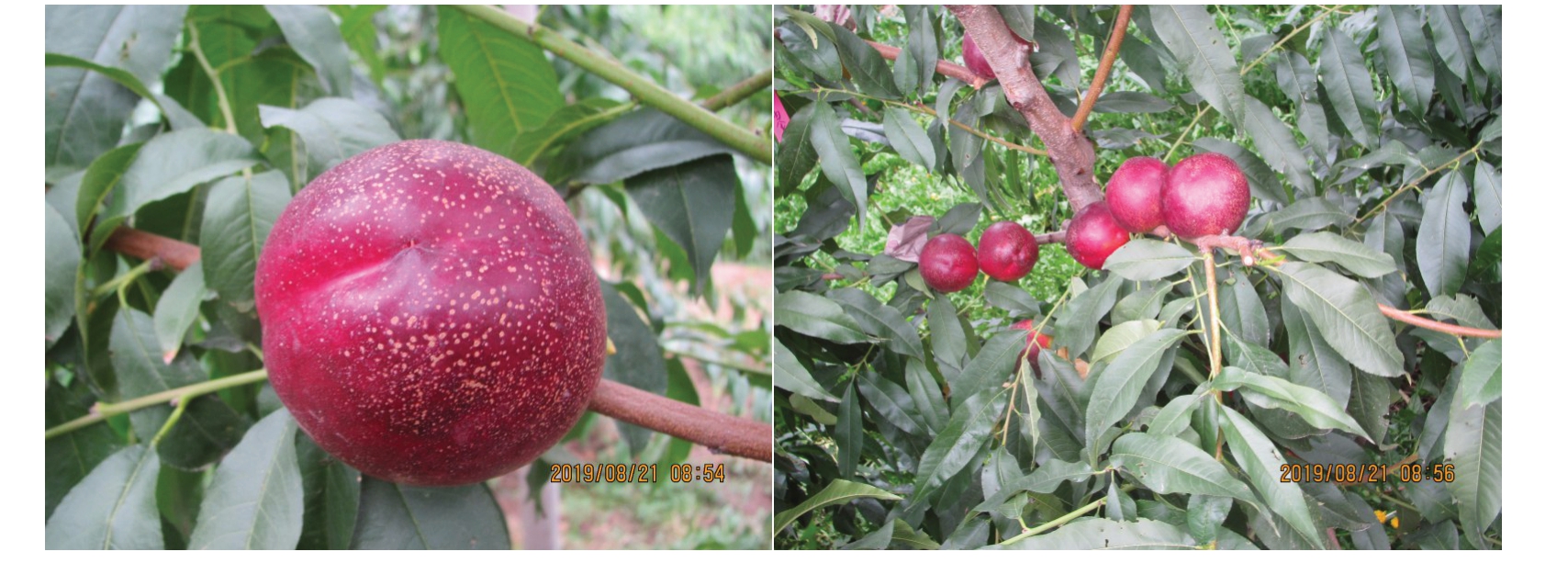桃是甘肃省主要栽培果树之一,在甘肃省桃主产区秦安县、皋兰县、七里河区等一些乡镇,农民收入的70%以上来自桃产业。甘肃省农业科学院林果花卉研究所从“十五”开始桃新品种的选育工作,先后选育出极早熟油桃甘露早油、早熟油桃陇油桃2号及早中熟油桃陇油桃1 号等白肉油桃新品种,而大果、黄肉甜油桃品种缺乏。国内油桃品种中,以早、中熟品种居多,中晚熟、晚熟品种较少[1-3],晚熟高糖度黄肉品种更少[4]。
1 选育经过
2008 年,以01-6-7-1(油桃187×瑞光3 号)为母本、瑞光28 油桃为父本进行人工杂交,杂交种子通过胚挽救技术最终获得杂种苗23 株。2011 年发现编号08-10-12的单株所结果实果个大、风味浓甜,初选为优株,经过连续3 a(年)观察,果实性状稳定并复选,2014 年高接并嫁接苗木,在甘肃省不同区域的5个区试点进行区试观察,经多年多点区试观察、评比和鉴定,该新品系性状遗传稳定,果实经济性状和栽培性状优良,终选为晚熟优良油桃品种,2018年定名为陇油金蜜。2020年7月获得农业农村部颁发的植物新品种权证书( 品种权号:CNA20184490.5),2020年9月获得农业农村部非主要农作物品种登记,登记编号:GPD 桃(2020)620012。
2 主要性状
2.1 果实经济性状
陇油金蜜果实圆形,平均单果质量212.0 g,大果质量242.0 g;果顶圆平;缝合线浅,两半部对称,梗洼浅;果皮底色浅黄,果面着红色斑点(图1),果皮厚,难剥离;果肉黄色,肉质致密,近核果肉花青苷积累多,硬溶质,汁液多,纤维少,味浓甜,可溶性固形物含量(w,后同)16.5%,可溶性糖含量12.9%,有机酸含量0.34%,维生素C 含量50.2 mg·kg-1。果核相对果实大小为中,褐色,卵圆形,黏核(表1)。果实去皮硬度9.27 kg·cm-2。适合鲜食。
表1 陇油金蜜与理想果实主要经济性状比较
Table 1 Comparison of main fruit characters of Longyoujinmi and Fantasia

品种Cultivar成熟期Ripening date风味Flavor核黏离性Stone陇油金蜜Longyoujinmi理想Fantasia 8月26日Aug.268月12日Aug.12平均单果质量Average single fruit mass/g 212.0纵径Longitudinal diameter/cm 8.0横径Transverse diameter/cm 8.1去皮硬度Peeling hardness/(kg·cm-2)9.27 w(可溶性固形物)Soluble solids content/%16.5 w(可溶性糖)Soluble sugar content/%12.9 w(可滴定酸)Acid content/%0.34162.67.47.57.1314.811.50.87浓甜Strong sweet甜酸Sour with slight sweet黏核Cling离核Free

图1 油桃新品种陇油金蜜
Fig.1 A new nectarine cultivar Longyoujinmi
2.2 植物学特征
树姿半开张,1 年生枝阳面红褐色,背面绿色。叶片长16.53 cm,叶片宽4.85 cm,长椭圆披针形,叶面平展、叶尖微向外卷,叶基楔形近直角,绿色;叶柄长1.06 cm,叶缘为钝锯齿;蜜腺肾形,2~4 个。花芽起始节位2~3 节。花蔷薇型,粉红色,花药橘红色,有花粉;萼筒内壁橙黄色,雄蕊与雌蕊等高。
2.3 物候期
在甘肃省兰州市,正常年份3 月下旬花芽开始萌动,4 月上中旬开花,花期6~8 d;4 月下旬展叶,5月上旬抽梢,8 月下旬果实成熟,果实生育期137 d左右。11月上中旬落叶,全年生育期233 d左右。
2.4 生长结果特性
树势较强,花芽形成好,复花芽多,各类果枝均能结果。2014 年春季成苗定植,主干形树形,株行距1.2 m×2.5 m,2016 年株产2.5 kg,2018 年株产8.6 kg,折合666.7 m2产量1909 kg,5 年生树年株产9.8 kg,折合666.7 m2产量2175.6 kg。
2.5 抗逆性及栽培适应性
陇油金蜜树体和花抗寒性均较强。经过多年、多点试验观察,在各区试点均表现出很强的栽培适应性和较强的抗逆性。对流胶病和细菌性穿孔病有较强抗性。适宜在甘肃省中东部的兰州、天水及南部的徽县等桃产区推广种植。
3 栽培技术要点
3.1 建园
建园时应选择水肥条件较好的地块。选用山桃做砧木。
3.2 整形修剪
休眠期以长枝修剪为主,夏剪主要采用疏枝、摘心、开展角度等措施,控制竞争枝和徒长枝。进入盛果期后,注意更新修剪,同时保持树冠的通风透光,有利于果实着色和品质的提高。
3.3 花果管理
陇油金蜜坐果率较高,应合理留果,有利于果个的增大和品质的提高。一般长果枝留果4~5个,中果枝留果2~3个,短果枝留果1~2个,花束状果枝可不留果或根据情况留1个果。每666.7 m2产量以2300 kg为宜。
3.4 肥水管理
陇油金蜜丰产性较强,应加强肥水管理。秋季每666.7 m2施腐熟有机肥2000~3000 kg,结合秋季施肥,施入氮素的60%,磷素的90%,钾素的50%;萌芽前施入剩余氮肥的20%、磷肥的10%;硬核期施入剩余氮肥的20%、钾肥的20%;果实膨大期施入剩余钾肥的30%。灌水便利的果园,每年及时浇灌萌芽水(兰州在3月中旬)、封冻水(兰州在11月中下旬),生长期根据土壤墒情浇灌。
3.5 病虫害防治
陇油金蜜无特殊病虫害。生长期根据病虫害发生规律,适时喷药防治。萌芽期(3 月上旬)全园喷3~5°Bé 的石硫合剂,消灭和减少越冬害虫和病源。落花80%(4 月中旬)第2 次清园,以防治梨小食心虫、蚜虫为主。5—8月份,以防治梨小食心虫、红蜘蛛和细菌性穿孔病、褐腐病等为主。农药要交替使用,以免产生抗药性。
[1] 郭继英,赵剑波,姜全,陈青华,李新越,于广水,任飞.晚熟油桃新品种‘瑞光39 号’[J].园艺学报,2011,38(10):2023-2024.GUO Jiying,ZHAO Jianbo,JIANG Quan,CHEN Qinghua,LI Xinyue,YU Guangshui,REN Fei.A new late ripening nectarine cultivar‘Ruiguang 39’[J].Acta Horticulturae Sinica,2011,38(10):2023-2024.
[2] 李延菊,张福兴,刘美英,孙庆田,张序,王玉霞,田长平,李芳东.晚熟油桃新品种‘福美’的选育[J].果树学报,2017,34(5):643-645.LI Yanju,ZHANG Fuxing,LIU Meiying,SUN Qingtian,ZHANG Xu,WANG Yuxia,TIAN Changping,LI Fangdong.Breeding of a new late ripening nectarine cultivar‘Fumei’[J].Journal of Fruit Science,2017,34(5):643-645.
[3] 王安柱,韩明玉,田玉命,张满让,王淑莉.晚熟耐贮油桃新品种‘秦光2 号’[J].西北林学院学报,2005,20(2):121-123.WANG Anzhu,HAN Mingyu,TIAN Yuming,ZHANG Manrang,WANG Shuli.A new late-ripening nectarine variety‘Qinguang 2’[J].Journal of Northwest Forestry University,2005,20(2):121-123.
[4] 王尚德,刘佳棽,蒋海月,周连第.中晚熟油桃新品种‘京和油2 号’[J].园艺学报,2012,39(8):1609-1611.WANG Shangde,LIU Jiashen,JIANG Haiyue,ZHOU Liandi.A new mid-late ripening nectarine cultivar‘Jingheyou 2’[J].Acta Horticulturae Sinica,2012,39(8):1609-1611.